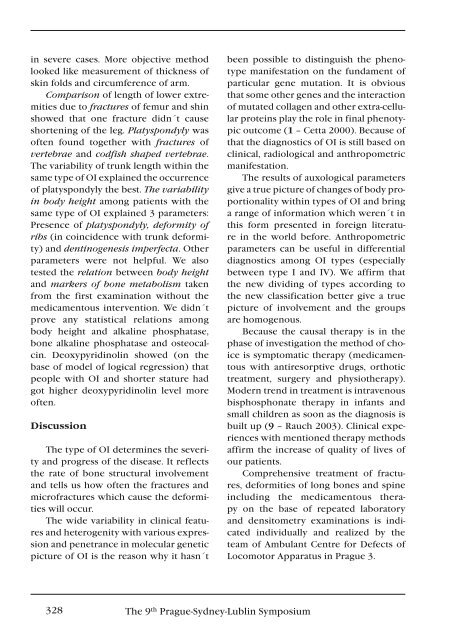Supplementum 3+4/2007 - SpoleÄnost pro pojivové tkánÄ›
Supplementum 3+4/2007 - SpoleÄnost pro pojivové tkánÄ›
Supplementum 3+4/2007 - SpoleÄnost pro pojivové tkánÄ›
You also want an ePaper? Increase the reach of your titles
YUMPU automatically turns print PDFs into web optimized ePapers that Google loves.
in severe cases. More objective method<br />
looked like measurement of thickness of<br />
skin folds and circumference of arm.<br />
Comparison of length of lower extremities<br />
due to fractures of femur and shin<br />
showed that one fracture didn´t cause<br />
shortening of the leg. Platyspondyly was<br />
often found together with fractures of<br />
vertebrae and codfish shaped vertebrae.<br />
The variability of trunk length within the<br />
same type of OI explained the occurrence<br />
of platyspondyly the best. The variability<br />
in body height among patients with the<br />
same type of OI explained 3 parameters:<br />
Presence of platyspondyly, deformity of<br />
ribs (in coincidence with trunk deformity)<br />
and dentinogenesis imperfecta. Other<br />
parameters were not helpful. We also<br />
tested the relation between body height<br />
and markers of bone metabolism taken<br />
from the first examination without the<br />
medicamentous intervention. We didn´t<br />
<strong>pro</strong>ve any statistical relations among<br />
body height and alkaline phosphatase,<br />
bone alkaline phosphatase and osteocalcin.<br />
Deoxypyridinolin showed (on the<br />
base of model of logical regression) that<br />
people with OI and shorter stature had<br />
got higher deoxypyridinolin level more<br />
often.<br />
Discussion<br />
The type of OI determines the severity<br />
and <strong>pro</strong>gress of the disease. It reflects<br />
the rate of bone structural involvement<br />
and tells us how often the fractures and<br />
microfractures which cause the deformities<br />
will occur.<br />
The wide variability in clinical features<br />
and heterogenity with various expression<br />
and penetrance in molecular genetic<br />
picture of OI is the reason why it hasn´t<br />
been possible to distinguish the phenotype<br />
manifestation on the fundament of<br />
particular gene mutation. It is obvious<br />
that some other genes and the interaction<br />
of mutated collagen and other extra-cellular<br />
<strong>pro</strong>teins play the role in final phenotypic<br />
outcome (1 – Cetta 2000). Because of<br />
that the diagnostics of OI is still based on<br />
clinical, radiological and anthropometric<br />
manifestation.<br />
The results of auxological parameters<br />
give a true picture of changes of body <strong>pro</strong>portionality<br />
within types of OI and bring<br />
a range of information which weren´t in<br />
this form presented in foreign literature<br />
in the world before. Anthropometric<br />
parameters can be useful in differential<br />
diagnostics among OI types (especially<br />
between type I and IV). We affirm that<br />
the new dividing of types according to<br />
the new classification better give a true<br />
picture of involvement and the groups<br />
are homogenous.<br />
Because the causal therapy is in the<br />
phase of investigation the method of choice<br />
is symptomatic therapy (medicamentous<br />
with antiresorptive drugs, orthotic<br />
treatment, surgery and physiotherapy).<br />
Modern trend in treatment is intravenous<br />
bisphosphonate therapy in infants and<br />
small children as soon as the diagnosis is<br />
built up (9 – Rauch 2003). Clinical experiences<br />
with mentioned therapy methods<br />
affirm the increase of quality of lives of<br />
our patients.<br />
Comprehensive treatment of fractures,<br />
deformities of long bones and spine<br />
including the medicamentous therapy<br />
on the base of repeated laboratory<br />
and densitometry examinations is indicated<br />
individually and realized by the<br />
team of Ambulant Centre for Defects of<br />
Locomotor Apparatus in Prague 3.<br />
328 The 9 th Prague-Sydney-Lublin Symposium
















